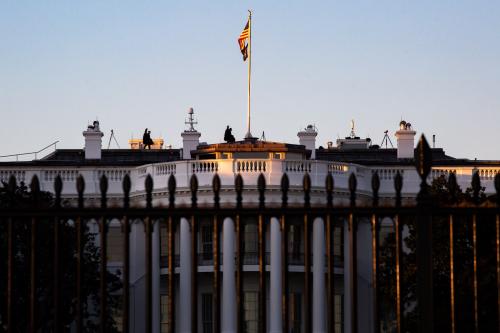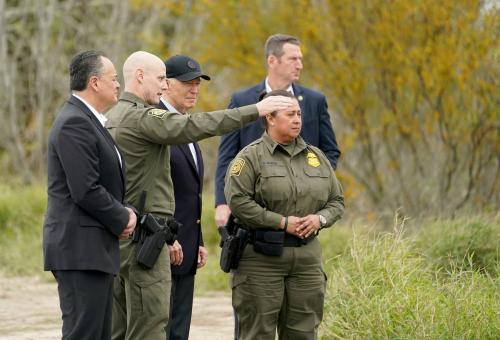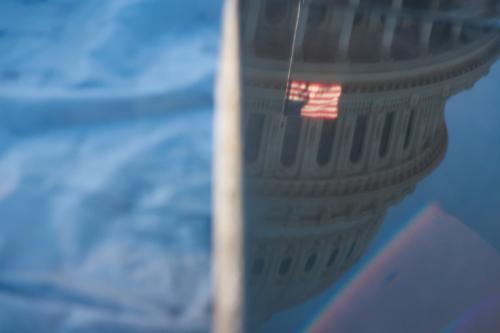As we enter an era of unchecked climate change, we should expect large population migrations to become a regular political phenomenon. According to the Intergovernmental Panel on Climate Change, tens of millions of people will become climate migrants in the coming decades. International migration tends to get the most attention, but internal displacements will also be severe. As temperatures rise, droughts become more severe, and storms and floods become more extreme, millions of Americans will be uprooted.
Our representative system is defined by human geography, and that geography will change in the coming decades. Migration will overturn our politics; the only question is how. This is the first in a series of articles drawing on history and social science to consider the potential effects of domestic climate migration on American politics.
Climate change is already putting pressure on the economic, political and social fabric of the United States; that fabric is already frayed, and the pressure of climate change will only grow. But doomsaying presents its own dangers. Encouraging lifeboat ethics can easily play into the hands of racists and authoritarians, and panic is rarely useful for policymaking. A different and perhaps more useful starting point is to recognize that the political consequences of migration have in the past been both immense and unpredictable.
For example, mass migration is at the root perhaps the most implausible storyline of the 20th century: the transition of the Democratic Party from the party of white supremacy to the party of civil rights. The parties’ realignment on race simply would not have occurred without the Great Migration: the movement, over roughly the six decades after 1910, of six million Black Americans out of the South.
As we prepare for a new era of mass internal migration, the story of how Black migrants and white Democrats in the Northern cities formed a political alliance has much to tell us. It is a story of how profoundly marginalized people, in the face of extraordinary ethnonationalist backlash, can build a powerful and enduring political coalition and reshape the nation. It is also a critical reminder that movements for justice can begin with alliances of convenience, and that winning material victories can long precede winning hearts and minds.
The “Jim Crow” Democratic Party
In the 1920s, there was little reason for optimism about racial justice in America, and no reason at all to expect the Democratic Party to champion the cause. In Tulsa, Oklahoma, in 1921, a white mob burned to the ground the prosperous Black neighborhood, the Greenwood District, killing hundreds and destroying millions of dollars of Black wealth—all with the support of local officials. The second Ku Klux Klan would peak in 1924, with a membership in the millions. Universities buttressed the “renewal of the Anglo-Saxon cult,” as W.E.B. DuBois put it, with eugenics, “scientific racism,” and fealty to the “Lost Cause” version of American history that glorified the Confederacy and impugned the capacity of Black people for self-governance.
The Democratic Party was, during this period of extraordinary racial intolerance, the party dedicated to the strictest form of white supremacy. It was Democrats who ruled the one-party Southern states that enforced the apartheid system known as “Jim Crow.” In the Senate, Democrats filibustered legislation intended to prevent and prosecute lynching. Even prominent economic liberals in the Democratic Party were racial conservatives. Woodrow Wilson was a proponent of labor standards and antitrust laws, but he was also a virulent racist: promoting segregation in federal agencies, firing Black government officials, and even screening the notorious celebration of the Ku Klux Klan, The Birth of a Nation, at the White House.
Asked to name the political party of the next president to sign major new voting protections for Black Americans, an informed political observer in the late 1920s would thus have undoubtedly guessed “Republican.” The GOP had long abandoned any substantive support for racial justice, but it was, after all, still the party of Lincoln. Asked to guess again, our Jazz Age pundit might well have answered “Communist.” The Communist Party platform argued for the abolition of racial discrimination as early as 1928. Yes, United States electing a Communist president would have seemed vanishingly unlikely—but still more conceivable than the idea that Democrats were going to advance the cause of Black civil rights.
But the Democratic Party was not just the party of the South. It was also the party of the cities, home to generations of Jewish, Polish, Irish, and Italian immigrants (all deemed racially inferior to Anglo-Saxons according to the so-called “race science” of the age). The diversity of the Democratic-run cities would soon be augmented by another massive migration—not from foreign shores, but from the American South.
The Great Migration and electoral politics
Driven by the oppression of the segregationist regimes and drawn by the promise of economic advancement in the North’s burgeoning industrial cities, six million Black Americans moved out of the South. Before the Great Migration, nine in 10 Black Americans lived in the South; by 1970, barely half did. As Isabel Wilkerson explains, it was a migration so vast that “the sheer weight of it” could “push the country toward the civil rights revolutions of the 1960s.”
As Black Americans moved to the North and the West, they changed the political calculus in the cities. Where Black people had at the turn of the century made up no more than one or two percent of the population, Black Americans by mid-century made up 10% or even 20% of potential voters. In New York, the Black population rose from less than 100,000 in 1910 to more than 1.6 million by 1970. In this same period, Pittsburgh’s Black population quadrupled, and Chicago’s increased 25-fold.
Once free of the Jim Crow regimes, the new arrivals were able to exercise their right to vote—and at first, they overwhelmingly voted Republican. The GOP was the party of Lincoln and of Frederick Douglass, the party that had ended slavery and enshrined voting rights in the Constitution—and then, with remarkable rapidity, abandoned its commitment to Black political equality. By the 20th century, the Republican Party was an amalgamation of Northeastern industrialists and more progressive interests from the rural Midwest and West—hardly the most obvious party to represent urban, working-class Black Americans.
The first signs of the partisan realignment were felt as early as 1928, when about a quarter of voters in a handful of Black urban precincts chose Democrat Al Smith, a representative of the ethnically diverse cities, over the conservative Republican Herbert Hoover.
But the real shift came in 1932. It started in Pittsburgh.
Robert Vann, the editor of the prominent Black weekly, the Pittsburgh Courier, was incensed by the Republican Party’s abandonment of civil rights and by the humiliations that he, a loyal Republican campaigner, had suffered at the hands of the Party. Vann suggested to local Democratic strategist Joseph Guffey that Black Americans, who had suffered disproportionately from the Depression, were ready to support FDR and the Democrats. Guffey jumped at the possibility, perhaps in part because he had little to lose: Pennsylvania had not voted for a Democrat for President since before the Civil War.
Guffey organized a meeting with Roosevelt’s campaign managers, and Vann became a leader of a new nationwide effort to rally Black votes for FDR. Vann made national headlines for a speech insisting that “I see millions of Negroes turning the picture of Lincoln to the wall. This year I see Negroes voting a Democratic ticket.” Vann’s impact in Pittsburgh was indisputable; though majority-Black wards in other industrial cities were still voting solidly Republican, FDR won Pittsburgh’s Allegheny County, aided by about 35,000 new Black Democratic voters. The trend only intensified in 1934, when five Black Democrats were elected to the Pennsylvania state legislature.
The partisan switch brought concrete gains to Pennsylvania’s Black citizens, with far more Black people appointed to government positions1 and the passage of a pathbreaking law barring discrimination in public accommodations.2 It also created a playbook for enterprising urban Democrats across the North. As the celebrated Black newspaper, the Chicago Defender, wrote in 1936, “the white Democratic North is getting independent,” telling their Southern counterparts, “‘We want votes and don’t give a damn.’”3 That year, nearly three-quarters of Black voters in the Northern cities voted Roosevelt.4
The Great Migration and the union movement
The shift of Black Americans into the Democratic column was not merely a matter of electoral calculation and enterprising political campaigning. The link between economic and racial justice was forged in the industrial union movement at the very moment that the unions were becoming the central organizing force of the “New Deal” Democrats. Again, the story starts with the Great Migration.
The arrival of Black Americans was felt both in the Northern voting booths and on the Northern industrial shop floors. By the 1930s, Black Americans made up a significant minority of the workforce in steel mills, automotive factories, and in meatpacking—often holding the most dangerous jobs.
On its face, this newfound diversity did not bode well for labor organizing. Northern bosses imported Southern labor, Black and white, to break strikes, and expected racial animus to keep whites-only unions from integrating. Some of the worst race riots in American history were linked with labor unrest; in East St. Louis in 1917, after aluminum manufacturing plants brought in Black strikebreakers, white workers murdered dozens of Black people including women and children, and burned whole neighborhoods, forcing 6,000 people to leave their homes. It was a massacre “done in the name of labor,” the crusading journalist Ida B. Wells would write. The labor unions “refuse to let Negroes work with them and murder them if they work anyway, in what they call ‘white men’s jobs.’”
By the mid-1930s, the more radical labor organizers recognized that a whites-only strategy would doom the industrial union movement. From its founding, the CIO, or Congress of Industrial Organizations, organized on an integrated basis. This was a tactical choice, but also an ideological commitment for many in the CIO’s leadership, who recognized race hatred as a threat to working-class solidarity. To its white membership, the CIO portrayed civil rights as integral to the success of the union movement, and in Congress, the organization lobbied for anti-lynching legislation alongside its bold economic agenda. The results were certainly imperfect—though Black members often served as union officers, they were rarely the president of their locals.5 But the CIO in the late 1930s was extraordinary for its level of racial inclusiveness; the number of Black union members increased sixfold, and the vast majority of these new union workers were in the CIO.
The CIO’s commitments overcame even relatively conservative Black leaders’ skepticism of unionism. When the CIO was organizing the steelworkers of Pennsylvania in 1937, Robert Vann, no radical in his personal politics, turned the Courier into an organizing force, telling its readers that the union “bids fair to become the outstanding labor organization on the continent” with to “a studied policy of NO DISCRIMINATION against Negroes.” Vann surely knew this was stretching the truth, but as a leading voice of Black Pittsburgh, his vote of confidence mattered; in Pittsburgh, Black steelworkers joined the union faster than whites.
The civil rights commitment of the CIO, one of the most powerful organizations in the New Deal coalition, helped define racial justice as a core part of the progressive agenda. It was a connection solidified, ironically, by the Southern white leadership that fervently fought both unionism and civil rights. Mississippi Senator Theodore Bilbo, the vehement white supremacist, described the CIO as a proponent of “social equality, which is communism in its worst form.” That Southern leaders equated and resisted unionism and racial justice helped white union members come to see racism as a danger to their own economic goals.
Though the New Deal would be marred by persistent racial discrimination, and the CIO would fail in its drive to unionize the South, the economic left was no longer divorced from the cause of civil rights. As Eric Schickler wrote in his landmark book, Racial Realignment, to be a “100% New Dealer” became a shorthand for those committed to economic and racial justice. Though the national Democratic Party did all it could to avoid the issue, the ideological battleground and the base of the Party had changed. It would take decades of struggle, but there was now a path to what would have only a few years earlier seemed impossible: the desegregation of the military, new civil rights legislation, and the passage of the Voting Rights Act— all signed by Democratic presidents.
Touchstones for today
As we think about the mass displacement due to climate change, what should we take from the story of the Great Migration? History will not repeat itself, of course. But, given the scale of the climate crisis, there is much to be learned from one of the largest domestic migrations in American history.
First, there is the obvious warning. The responses of white Northerners to the Great Migration—including white flight, disinvestment, and the “war on crime”—are archetypal examples of the kind of ethnonationalist backlash and systemic injustice we must avoid in response to the climate crisis. The decisions we make in the coming years will ramify for generations. Economist Ellora Derenoncourt has found that whites’ reaction to the Great Migration, resulting in segregation and incarceration, explains more than a quarter of the racial gap in Northern upward economic mobility today. Black assets, neighborhoods, and communities remain immensely undervalued, as my colleague Andre Perry has demonstrated.
But political import of the Great Migration should not be reduced to the racist reaction it engendered. Despite the persistent racism of Northern whites, the Great Migration resulted in the extraordinary political feat of Black political incorporation in the Democratic Party of the Northern cities, an essential precursor to the civil rights movement. The story should remind us that powerful political coalitions can be built even in the face of immense opposition.
In fact, backlash can occasionally help make clear the new lines of political contestation. Southern opposition to the CIO unintentionally but materially assisted in the building of ties between racial and economic justice. In their fierce resistance to both racial equality and union power, and their oft-voiced conviction that unionization was inherently a danger to the racial order, Southern conservatives helped cement the connection for white union supporters that civil rights was indeed a part of their agenda.
It is worth recalling, also, that the early alliances between Black Americans and white Democrats were alliances of convenience as much as or more than conviction. Black and white leaders recognized that a cross-racial alliance could result in increased power and material gains, and they built institutions that could channel that potential into visible and substantive wins: election victories, policy changes, patronage positions, and union contracts. It was not simply the presence of Black people in Northern cities and industrial workplaces that reconfigured the Democratic Party. It was the concerted effort of political campaigners working to achieve immediate and material ends.
The people who achieved these victories were often motivated by expedience. Joseph Guffey, the Democratic strategist who believed in the possibility of wooing Black voters in Pennsylvania, was widely portrayed by his contemporaries (and by historians) as ambitious, rather than ideological. And Robert Vann, whose newspaper provided a flood of positive coverage to the CIO during its critical campaign to organize Pennsylvania’s steelworkers, was not a consistent supporter of unionism. Vann’s politics were moderate and pro-business, guided by the work of Booker T. Washington; in his early years, he defended and even participated in strikebreaking. More broadly, while ideological militants in the union movement saw racism as a danger to class consciousness, plenty of white union members simply recognized that, if a quarter of the workers in an industry are Black, an industrial union movement could only succeed on an integrated basis.
Over time, these bonds of convenience can become something more profound. Black Americans today have more positive attitudes about unions than whites do (and are more likely to be union members themselves). A recent study demonstrates that, not only are white union members less racially resentful than other whites, but that becoming a union member actually reduces whites’ racial resentment. These enduring links are a consequence of the political realignment that began at the start of the New Deal. But the possibility of a multiracial working-class movement did not start with a campaign to convert hearts and minds, it started with an effort to win power.
Conclusion
The partisan realignment that followed the Great Migration should encourage our humility in our capacity to predict the future—a humility that can keep us from cynicism and despair. The idea that mass migration could result in something as astonishing as reversing the Democratic Party’s position on white supremacy should humble us as we assess our capacity to predict what the future holds, and inspire us to build the institutions necessary to create political opportunity on the scale climate change requires.
-
Footnotes
- Weiss, Nancy J. Farewell to the Party of Lincoln: Black Politics in the Age of F.D.R. Princeton University Press, 1983. 94.
- Schickler, Eric. Racial realignment: The transformation of American liberalism, 1932-1965. Princeton University Press, 2016. 49.
- Schickler, 51.
- Schlozman, Daniel. When movements anchor parties: Electoral alignments in American history. Princeton University Press, 2015. 67.
- Schlozman, 67.
The Brookings Institution is committed to quality, independence, and impact.
We are supported by a diverse array of funders. In line with our values and policies, each Brookings publication represents the sole views of its author(s).







